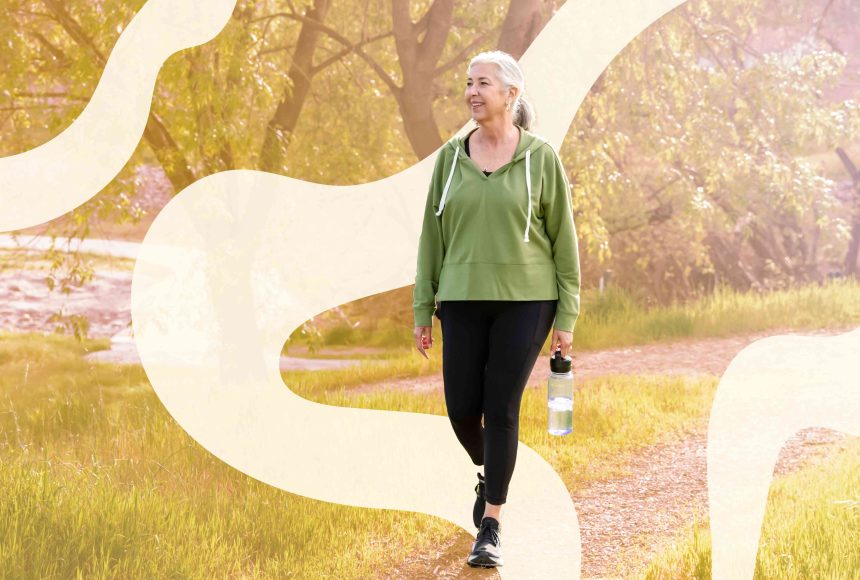When it comes to aging, we employ all kinds of tricks to look younger—from coloring hair to Botox injections and anti-aging creams. But is there some way to actually slow aging—from the inside-out? In short, the answer is yes. While how quickly we age is partly determined by our genetics, lifestyle plays a large role, too.
The great news is that there are plenty of healthy habits you can pick up, from getting active to cooking lean proteins. And in a new study published in Nature Aging, researchers examined how three of these habits—omega-3 supplementation, vitamin D supplementation and a simple home exercise program—could influence aging at the cellular level. Let’s take a look at what they found.
How Was This Study Conducted?
To understand the current study, we should start with some previous research that this team of scientists published back in 2020. Their study, called the DO-HEALTH trial, lasted three years and included more than 2,000 generally healthy adults aged 70 or older. As part of the study, participants were randomly assigned vitamin D supplementation, omega-3 supplementation, strength-training exercise and combinations of the three.
Participants had bloodwork done at baseline and annually throughout the three-year trial. DNA was extracted from their blood and biobanked so that researchers could look at aging on a cellular level. For that purpose, researchers use epigenetic clocks, which are tools that estimate a person’s biological age based on DNA methylation (DNAm) patterns. Epigenetics refers to how your environment and behaviors influence how well your genes work, including turning genes on and off. Epigenetic clocks are used to predict life expectancy and mortality risk, and also measure “healthspan”—the number of years one is likely to live in good health.
Researchers used data and DNAm samples from the DO-HEALTH trial for this newer study. The new study included 777 participants, all of whom were Swiss. About 59% of the participants were women, and they had an average age of 75 when the study began. This smaller participant group was slightly different than the larger original group—a third of them had below-average blood levels of vitamin D, and as a whole, the smaller group had lower baseline blood levels of omega-3s compared to the full cohort.
Using the DNAm samples from the beginning and end of the study, researchers used several different epigenetic clocks to determine whether any of the interventions and combinations of interventions seemed to slow biological aging at the cellular level.
What Did This Study Show?
According to these researchers, participants who took omega-3 supplements seemed to show the greatest response for DNAm. In other words, their cells weren’t aging as quickly as might be expected for their chronological ages. They also state that those who started the study with lower levels of omega-3 exhibited greater epigenetic shifts. This would suggest that omega-3s may have the ability to not only slow but to reverse the aging process at the cellular level.
In addition, several of the epigenetic clocks used in this study supported additional improvements when all three interventions were employed—omega-3 and vitamin D supplementation and a simple home exercise program. One of the clocks showed a 1% reduction in the pace of aging, while two others showed a reduction in aging by about three to four months.
In other words, over the study’s three years, participants added three or four months to their lives by supplementing with omega-3s and vitamin D and exercising.
How Does This Apply to Real Life?
Epigenetics is still a fairly new area of science, but it’s a fascinating one. While we tend to focus on the external effects of aging, what we see on the outside starts on the inside.
In the study at hand, there was strong evidence for omega-3 supplementation as it related to cellular aging. And even stronger evidence for a combination of omega-3 and vitamin D supplementation plus regular exercise. Does this mean everyone should supplement with these nutrients? Not necessarily.
The study authors state that their results support personalized approaches to help slow aging and improve healthspan. In other words, blanket nutritional recommendations don’t work for everyone. While we all need omega-3s and vitamin D, how we get these nutrients is different for everyone. Some people may not need supplementation for either of these nutrients because they’re getting enough omega-3s in their diets and live in a climate where they get enough sunlight exposure for their bodies to produce vitamin D.
Omega-3s are found in fatty fish, like salmon, tuna, sardines and mackerel, as well as nuts and seeds like walnuts, chia seeds and flax seeds. And vitamin D is in egg yolks, mushrooms, fortified milks and fortified orange juice. It’s also in salmon, so you can get your omega-3s and vitamin D in a single delish dinner.
Everyone also needs physical activity, but similar to nutrition, how you get it and what you do will depend on your current fitness level, lifestyle, physical abilities and preferences. For this study, participants exercised for 30 minutes three times each week. If that goal seems unapproachable, start small with a walk around the neighborhood in the morning and build up from there.
If you’re concerned about meeting your nutritional needs, you can request bloodwork from your healthcare provider to test the levels of nutrients in your blood. Then ask for a referral to a registered dietitian who can take your bloodwork results and help tailor an eating strategy that fits you. An RD can also help determine if supplementation is necessary.
The Bottom Line
This study suggests that omega-3s, vitamin D and exercise influence cellular aging by providing some level of protection, thereby slowing the aging process. It’s important to note that many other things can help or hinder you on that front, whether it’s enjoying your morning cup of coffee or getting rid of mold in your home.
Take a whole health approach and choose one area to begin working on. If you want to start with the nutrients in this study, begin incorporating more fatty fish, nuts and seeds into your diet. Since exercise also played a role, start moving more. If you’re currently not a regular exerciser, start by taking movement breaks throughout your day. Do a set of stairs, walk a lap around your house or do some push-ups off your kitchen counter. Start with something and gradually add to it. Remember, something is better than nothing—and over time, it all adds up.






